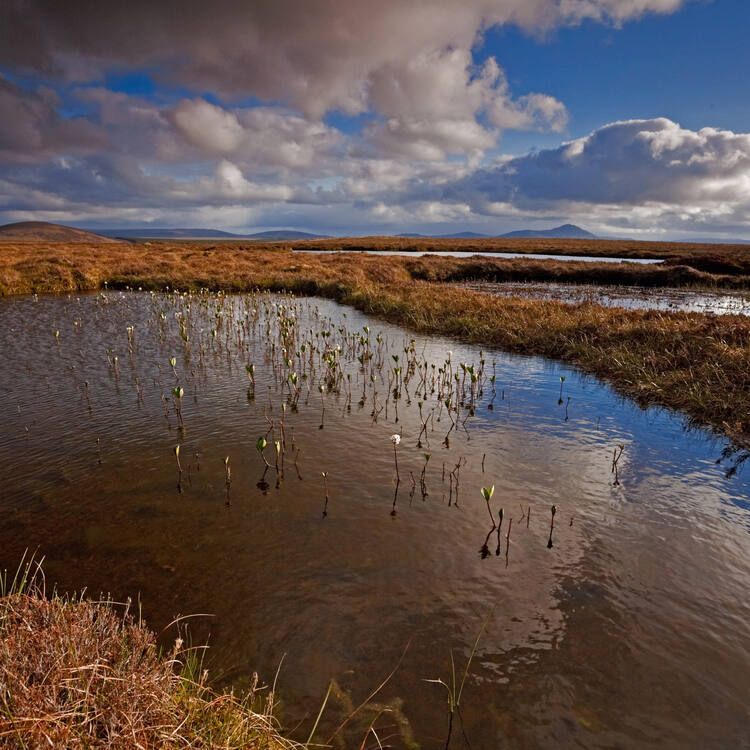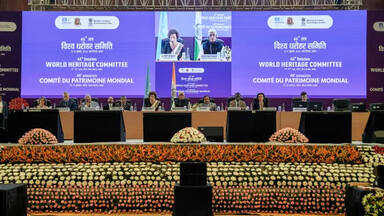The Flow Country
The Flow Country
The serial property, located in the Highland Region of Scotland, is considered the most outstanding example of an actively accumulating blanket bog landscape. This peatland ecosystem, which has been accumulating for the past 9,000 years, provides a diversity of habitats home to a distinct combination of bird species and displays a remarkable diversity of features not found anywhere else on Earth. Peatlands play an important role in storing carbon and the property’s ongoing peat-forming ecological processes continue to sequester carbon on a very large scale, representing a significant research and educational resource.
Description is available under license CC-BY-SA IGO 3.0
Le Flow Country
Ce bien en série, situé dans la région des Highlands d’Écosse, est considéré comme le paysage de tourbières de couverture en accumulation active le plus exceptionnel. Cet écosystème, où la tourbe s’accumule depuis 9 000 ans, offre une diversité d’habitats abritant une combinaison distincte d’espèces d’oiseaux et présente une diversité remarquable de caractéristiques unique au monde. Les tourbières jouent un rôle important dans le stockage du carbone. Les processus écologiques en cours formant la tourbe séquestrent le carbone sur une très vaste échelle et représentent donc une ressource importante en matière de recherche et de pédagogie.
Description is available under license CC-BY-SA IGO 3.0
ذا فلو كنتري
يُعتبر هذا الموقع المتسلسل، الواقع في منطقة المرتفعات الاسكتلندية، أبرز مثال على النحو النشط الذي تشكلت فيه مناظر المستنقعات الطبيعية. وتجمّعت أجزاء هذا النظام البيئي للأراضي الخثية على مدار 9000 سنة مضت، وهو يوفر موائل متنوعة تؤوي مجموعة فريدة من الطيور، ويكتنز تنوعاً ملحوظاً من الخصائص التي ينفرد فيها هذا الموقع. تؤدي أراضي الخث دوراً هاماً في تخزين الكربون، وتواصل العمليات البيئية المستمرة لتكوين الخث في هذا الموقع عزل الكربون على نطاق واسع للغاية، الأمر الذي يوفر مورداً بحثياً وتعليمياً بالغ الأهمية.
source: UNESCO/CPE
Description is available under license CC-BY-SA IGO 3.0
弗罗湿地区
弗罗湿地区(Flow Country)系列遗产位于苏格兰高地,被视为持续累积的覆被泥炭沼泽的最典型范例。这一泥炭生态系统在过去9千年间不断累积,为多种鸟类提供了多样的栖息地,并展现出全球独一无二的丰富特性。泥炭地在碳储存方面发挥着至关重要的作用。该地区持续形成泥炭的生态过程目前还在继续储存大量碳,具有重要的研究和教育价值。
source: UNESCO/CPE
Description is available under license CC-BY-SA IGO 3.0
Флоу-Кантри
Этот серийный объект, расположенный в области Хайленд в Шотландии, является выдающимся примером активно растущего покровного болота. Эта торфяная экосистема, которая формировалась на протяжении последних 9 000 лет, позволяет сохранять разнообразную среду обитания. Здесь обитает множество видов птиц, а также наблюдается удивительное разнообразие свойств ландшафта, аналогов которому нет нигде на Земле. Торфяники играют важную роль в накоплении углерода, а протекающие в них экологические процессы, связанные с образованием торфа, способствуют масштабному поглощению углерода. Благодаря этому объект имеет большое значение для научных исследований и образования.
source: UNESCO/CPE
Description is available under license CC-BY-SA IGO 3.0
Flow Country
Este sitio en serie se sitúa en la región escocesa de Highland y se considera el ejemplo más destacado de paisaje de turberas formadas por acumulación activa. Este ecosistema de turberas, que se ha ido acumulando durante los últimos 9000 años, proporciona una gran variedad de hábitats que albergan una combinación singular de especies de aves. Además, presenta una extraordinaria diversidad de características que no existen en ningún otro lugar del planeta. Las turberas desempeñan un papel importante en el almacenamiento del carbono, y los procesos ecológicos de formación de turba siguen secuestrando el carbono a gran escala, representando así una importante fuente educativa y de investigación.
source: UNESCO/CPE
Description is available under license CC-BY-SA IGO 3.0
Outstanding Universal Value
Brief synthesis
The Flow Country is considered the most outstanding example of a blanket bog ecosystem in the world. This blanket peat and its intricate network of pools, hummocks and ridges stretches across nearly 190,000 ha of the northern mainland Scotland, with the boundary comprising seven separate but proximal areas. The peat has been accumulating for the past 9,000 years and displays a remarkable range of features resulting from the climatic, altitudinal, geological and geomorphological gradients found across the region. Peatlands play an important role in storing carbon, and The Flow Country has an extensive record of peatland accumulation, with peat thicknesses which reach over eight metres. Ongoing peat-forming ecological processes continue to sequester carbon on a very large scale.
The Flow Country blanket bog also provides a diversity of habitats, combined with the patchwork of connected farming and coastal landscape elements within the wider setting. The area supports a distinctive assemblage of birds, with a combination of arctic-alpine and temperate and continental species.
Protection for The Flow Country is provided through international and national designations, and national, and local planning law and policy, and there is scope for future expansion of the property through restoration of adjacent degraded blanket bog. The area is also considered to be the type-locality for description of blanket bog and so represents a significant research and educational resource.
Criterion (ix): Since the glaciers receded from Scotland, climatic conditions in combination with the underlying geology, the resultant topography, and the biogeography have led to the formation of a vast and diverse blanket bog landscape that stretches across the north of Scotland. The persistent precipitation-fed waterlogging of the soil has led to an expanse of peat bog that blankets the landscape, including hills, slopes and hollows, and forming a globally rare and significant peatland ecosystem and associated species assemblage. The property represents the most extensive, near-continuous, high quality and near-natural blanket bog landscape found globally. The active processes of blanket bog formation have continued for 9,000 years, and the diversity of blanket bog features is not found anywhere else on Earth.
The blanket bog also provides a highly significant record of its formation, preserved as pollen and plant fossils, and telling a story of its past flora, fauna, palaeoecology and human influence. This is important for the understanding of the future evolution of this and other blanket bogs globally. Moreover, the processes of blanket bog formation provide a significant example of carbon sequestration on a large scale.
The property holds between 29 and 34 peat forming species of Sphagnum moss, which are themselves home to complex assemblages of unique microorganisms adapted to survive in the low oxygen, cold temperature, acidity, and oligotrophy conditions of bog systems, adding to the biodiversity value of peatland habitats, and which also provide refuge for many breeding bird species. The property hosts a particular biodiversity assembly with specific communities composed of Atlantic, boreal and arctic taxa.
Integrity
The Flow Country property comprises seven discrete but adjacent areas totalling nearly 190,000 ha, which encompasses a large expanse of actively accumulating blanket bog ecosystem. The overwhelming majority of the blanket bog within the property boundary is in near-natural condition. The remainder includes areas of blanket bog that are undergoing restoration, and areas that are expected to be restored in the near future.
The property is of sufficient size to contain all of the elements of Outstanding Universal Value needed to demonstrate the ecological and biological processes, and the biodiversity that comprises this globally significant ecosystem. These include the blanket bog itself, the wider peatland landscape complex in which it lies and the finer elements, including pool systems, diverse surface patterning, fens, and the range of flora and fauna that all of these systems support. The climatic, altitudinal, geological and geomorphological gradients that occur across the Flow Country all contribute to ensuring that the variety of features that make up blanket bogs are represented. Furthermore, the boundaries of the property are largely defined on the basis of the hydrological elements that comprise the blanket bog, and therefore ensure ecosystem integrity and coherence.
Areas of the property have suffered from poor historical management decisions such as drainage and woodland creation, but the boundary has been chosen to include only those areas of deep peat which are in good condition or have the ability to return to a near-natural state within the next 10-25 years. It is expected that in time, it will be possible to integrate some of the bog of the wider Flow Country into the property. The construction of wind turbines represents a more recent threat to the property through supporting infrastructure and through negative impacts on the avian fauna, which constitutes an integral part of the blanket bog ecosystem.
Protection and management requirements
The property is legally protected in its entirety based on its Outstanding Universal Value. Around 73 percent of the area within the property boundary has the highest level of statutory protection that domestic law can provide: SSSIs, SACs (for habitats), SPAs (for birds) and a Ramsar Site (for wetlands). These laws provide specific protection for the elements of Outstanding Universal Value as set out in the property’s attributes, notably including the processes for the maintenance and formation of blanket bog, and the associated flora and fauna.
Further to statutory environmental protection, peatlands, particularly those containing deep peat greater than 50 centimetres, are protected through the planning system for Scotland, both at national and local level. There are specific planning policies at national level in relation to both World Heritage properties and areas of peatland that afford effective protection from development proposals that might impact upon Outstanding Universal Value. Moreover, where the boundary is not coincident with existing environmental designations, protection will be ensured by national and local planning policy.
The property has no buffer zone. However, areas important for the protection of Outstanding Universal Value outside of the boundary are protected through a combination of national and local planning policy, and the wider protection of features afforded by the existing European-level environmental designations. In addition, the integrity of the property is ensured thanks to its large size and the inclusion of areas that provide a buffering function within the property boundaries.
Management of the property’s Outstanding Universal Value is guided by a single clear Management Plan, developed by the Flow Country Partnership in collaboration with key stakeholders such as landowners and managers, government agencies, local communities and scientific experts. Management requirements include bog restoration, monitoring of and responding to any potential developments in the vicinity of the property, including the construction of wind turbines. Potential threats include woodland restocking and natural regeneration, water management and drainage, intensive agriculture, wind farms, inappropriate deer management, burning and climate change. A key requirement for the management of this property lies in continued strong and adequately resourced coordination and partnership arrangements focused on the World Heritage property and its Outstanding Universal Value.

